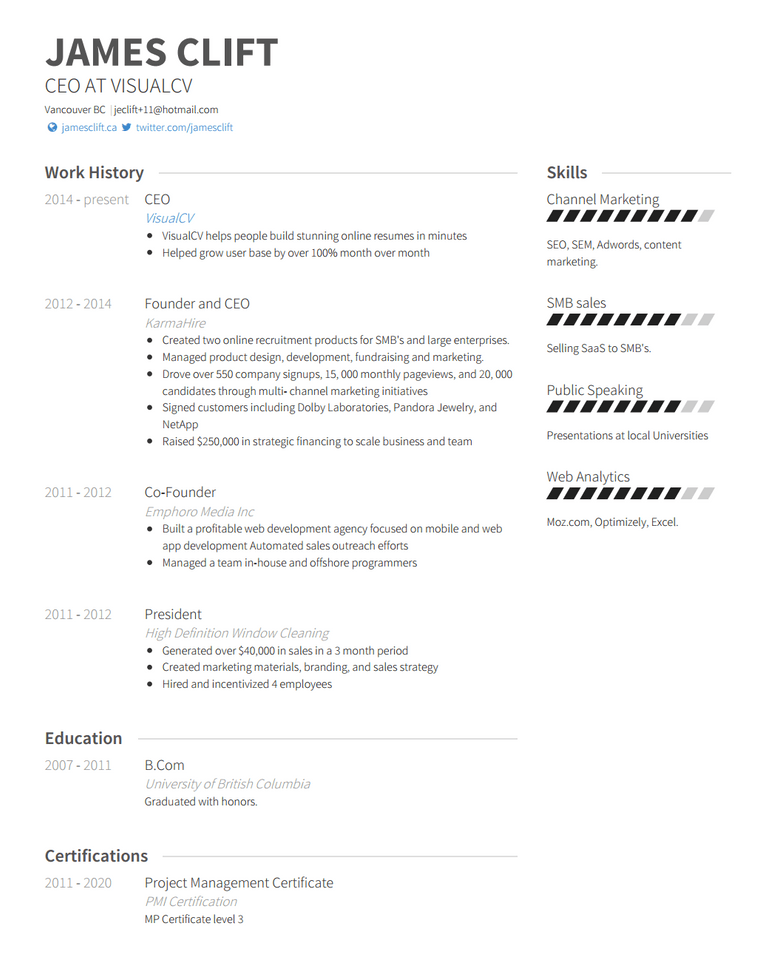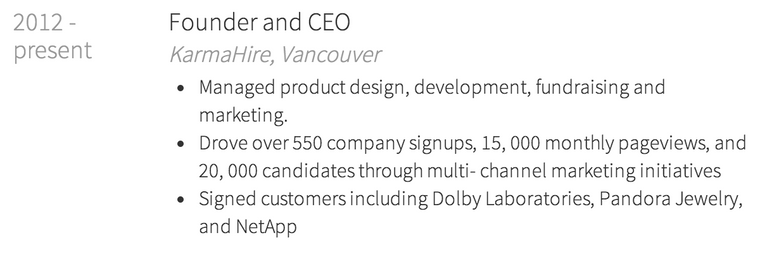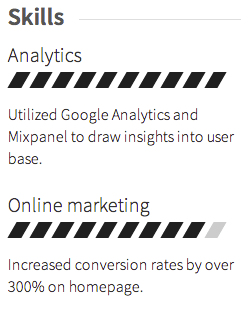![The 2025 Resume Writing Guide [+ Job Search Tips and Resume Examples]](/static/0a451b7c20b67c3a0ce6a7b4a7680f5f/1ebf6/Resume_Guide.jpg)
The 2025 Resume Writing Guide [+ Job Search Tips and Resume Examples]

Searching for a new job is one of the hardest things you'll have to do in your career and it's no easier this year. The Great Resignation, intense competition from other job seekers and remote work are making it one of the most exciting and challenging job markets we've seen in years.
That's why we decided to create our 2025 Resume Writing Guide with job search tips, resume examples and all the information you need to create the perfect resume or CV.
The right job is one of three things that contribute most to your happiness in life.
Which is why you need to do it right.
Besides you, your resume is your most important tool in a job search.
It is your first impression with employers.
It is the difference between an interview for your dream job or the recycle bin.
A great resume makes searching for a job easy, while an ineffective resume will leave you with nothing to show from hundreds of applications. Applying to a job without a good resume guide is a waste of time and can add months (or even years) to your job search, leaving you frustrated and demotivated. The following is a guide to creating a stand-out resume that gets you hired.
Recommended links:
- Our collection of 500+ professional resume examples.
- Our gallery of 20+ downloadable resume templates.
Let's start with the basics.
Resume Layout Guide
A resume is your professional highlight reel - presented in an easily understood and standardized format.
Your resume needs to solve a problem for employers (which is why they’re hiring). It is your most important tool to landing an interview, and ultimately a job.
There are three standard resume layout types.
- Chronological: Focuses on work experience in reverse chronological order.
- Functional: Focuses on skills and experience, and not chronological work history. Used by people with gaps in employment or are changing careers.
- Combination: Enables you to highlight the skills and experiences that are relevant, while still showing work history in the format that employers prefer.
Which type of resume layout is best depends on the situation. For each job application, choose the layout that best represents you in the context of the job you're applying for.
Important Resume Guidelines
Long gone are the days when recruiters and employers sit in uninterrupted silence and carefully read multi-page resumes from cover to cover. Nowadays, interruptions and distractions are the norm, and recruiters' time is increasingly crunched.
90% of large corporations use Applicant Tracking Software that to manage their recruiting process, which means you need to get through an automatic screen before your resume is even seen by an employer. If you make it past that step, studies have shown that recruiters spend 6 seconds on average reviewing a resume.
Studies show that recruiters spend on average 6 seconds looking at a resume.
They need to quickly pull out key facts, and make a split second decision that could decide your future. We think there are two key resume guidelines you need to keep in mind when building your resume.
Does your resume pass the 7-second test? Recruiters only spend 7.4 seconds reviewing your resume before moving it to the 'YES' or 'NO' pile.
If you pass the test, you still need to hold their attention to make it to the next steps.
Your resume needs to be sharply focused, compelling, and entirely relevant.
What is an applicant tracking system?
An applicant tracking system (ATS), is software that organizations use to manage their recruitment process. Vendors include Taleo, The Resumator, Smart Recruiters, and many more.
Most applicant tracking software uses a process called resume parsing, which extracts your resume data into a format readable by the software. Resume parsing pulls your contact information, work history, and skills from the resume.
When a recruiter is searching within their applicant tracking system for a candidate, those that best fit the keywords of the job description will show up first in the search results based on the parsed resume data.
This is why thinking about these guidelines is important in optimizing your resume for each application. We actually offered some tips on how to beat the ATS in a previous blog post.
Before writing your resume
If you're unsure about your career objective or haven't quite settled on a goal, you'll find that writing a powerful and effective resume is extremely difficult.
Remember, your resume must present just the right mix of meaningful information relevant to your goal.
Without a goal, you don't know what information to include, what skills or successes to highlight, and what details to omit. You're forced to include everything, and the end result is usually a resume that does not capture interest because it's not focused.
Have a clear goal before writing your resume. Employers want to know what you want to do; it's not their job to figure that out. Take the time to define a goal (or multiple goals) before writing your resume.
See our guide on How to get a better Job for more exercises and resources for deciding what you want from your career.
Once have a clear goal for your resume, move on to the next step.
Be Clear About Who You Are
In the context of your resume, "who you are" usually refers to a job title.
Are you a Software Engineer?
Corporate Finance Executive?
Customer Service Representative?
Be sure to include this critical information right up front, as a headline or in the first sentence of your introduction. Your goal is to immediately communicate to employers the essential information that creates the context for everything else they will read in your resume.
For example, if you define yourself as a "Sales Professional," employers will be looking for key qualifications such as sales results, communication skills, relationship-building abilities, territory management experience, and so forth.
If you define yourself as an "Accountant," they'll be looking for something entirely different accounting and finance experience, knowledge of accounting software, attention to detail, and strong analytical skills.
By defining yourself up front, you establish expectations and help readers better appreciate and absorb the information that follows.
Paint the picture of an ideal candidate
Study the job description and decipher what problems the employer wants solved. Employers don’t care about you. They care about solving their problems. This is the only reason why they are posting a job. Get into their heads, and try to understand their pain.
Why are they posting this job? Who is the ideal candidate for the job? Which skills does the ideal applicant have?
Write down a brief description of the ideal applicant in the third person, all the way down to what they’re wearing. This will help you decide how to represent yourself when creating your resume.
Having defined your "ideal self," consider what information you can place "front and center" on your resume to support your claim. What credentials, qualifications, experiences, knowledge, and accomplishments do you possess that will prove you are, in fact, an effective Marketing Management Professional?
Your goal is to create a "snapshot," a capsule portrait that conveys the most essential information to your readers. In essence, you want to quickly portray that you are an ideal candidate for the types of jobs you are pursuing.
Preparing Your Resume
In your job search, you will need to create a distinct resume for each job application. This enables you to do the following:
- Tailor each resume to suit the job description
- Optimize your resume keywords for applicant tracking systems
- Choose a distinct style to suit the company
To make this easy, start by building a Master Resume to work from. This will be an ever-evolving resume that contains all your work history, accomplishments, and skills that you can tailor for each application.
Let's start building a Master Resume.
How to Create Your Resume, With Examples
The following section will outline the key components of a resume, and provide examples, tips and best practices for writing these components.
Standard fields
- Header
- Summary/introduction
- Work Experience
- Education
- Skills
Optional Fields
- Past Projects
- Publications
Resume Example:

Your Resume Header
Your resume should first include the most important information - Your name! Your name should be the largest text on the page. The header also includes basic contact details and links to other relevant online profiles.

For a European CV, the header will also include a professional profile picture. Do not include a picture for a traditional North American application. For a web based North American resume, a picture is acceptable.
Your Resume Summary and Introduction: Examples of What You Should Include
An objective statement is no longer acceptable on your resume summary or resume introduction. Employers know your objective is to get the job. Instead, you have two options.
- Write a summary or introduction that highlights your most valuable accomplishments and skills.
- Do not include a summary or introduction.
The introduction goes after the header information, and should serve the following purposes:
- Highlights your the most valuable aspects of your resume
- Draws the reader in, and encourages them to read more
Resume Introduction Examples
Bad example: Experienced professional seeking employment in the financial services sector.
Good example: Experienced financial planner who has consistently generated above market returns for clients. Thrives in a team-oriented and high pressure environment.
Bad example: Passionate marketing manager and creative problem solver who loves to work with great people.
Good example: Results-driven marketing professional with over 10 years experience working with blue-chip clients including Nestle, Google, and Intel.
Remember, the introduction is not a necessary element. If you're going to use it, do so wisely. No introduction is better than a poor one.
Citing Your Work Experience
The most valuable section of your resume is the work experience section. It is usually the most important factor in getting a job. Highly relevant experience in a field is the first thing employers look for. Even for entry level jobs employers want to see relevant experience.
Ordering Your Work History
Most commonly, work experience is displayed in reverse chronological order, with your most recent job first. If you do have a highly relevant position, there is no rule against re-ordering your work history to put the most relevant job first.
Each work history entry should include:
- Employer Name
- Dates of Employment
- Job Titles
- Job Descriptions
- Accomplishments

The most crucial aspect of your career history is to write accomplishments, not history. Your job title and regular duties don't matter - what matters is your most impressive achievements in those positions. Ensure your accomplishments are compelling. Accomplishments are best written in bullet-point format, underneath each job title held.
Resume Example Accomplishment Statements
Bad example: Promoted to senior account manager with full responsibility for the company’s #1 client.
Good example: Promoted to senior account manager to manage #1 client, growing the business from $3 million to $6 million in 2 years.
Bad example: Completed all projects under time and under budget.
Good example: Averaged 7% under budget while completing 100% of projects on schedule, 65% ahead of schedule.
Bad example: Managed a portfolio for blue-chip clients that generated high returns.
Good example: Responsible for $5 million in assets for high net worth clients that generated a return of over 12% in 2013.
Bad example: Kept customers happy.
Good example: Increased referral rates by 15% and maintained a customer satisfaction rate of over 95%.
Writing Effective Resume Accomplishment Statements
The following section is a series of questions designed to help you quantify your performance in a position to write better accomplishment statements. Spend an hour answering these questions in relation to each job you've held. This will give you "ammunition" to work with when writing your resume.
Questions to quantify performance
- Did you make money for the company?
- Did you increase market share?
- Did you improve your ranking in comparison to other departments, branches, or competitors?
- Did you suggest any ways to cut costs in your team, department, unit, branch, or company?
- Did you regularly meet all your deadlines?
- Did you improve the efficiency of your job, team, or department?
- How did your performance compare to prior years?
- How did you rank against the competition?
- How did you rank against industry averages?
- What were your performance goals? Did you meet them? Exceed them?
- How did you contribute to the bottom line?
Questions to reveal success factors:
- What are you most proud of?
- What did supervisors compliment you for?
- What do your performance evaluations say?
- What are you known for?
- What do you do that others can't or don't do?
- What would "fall apart" or "slide downhill" if you weren't at your job for a week?
- What do you have "bragging rights" about?
- Where you the first, best or most effective in any particular function or organization?
Questions to create strong introductory statements
- What is the most important thing I accomplished in that job?
- What was I initially hired to do? Did I do it?
- What major challenge was I presented with? Or what major challenge did my company or industry face, and how did I surmount that challenge?
- What happened to my company or department as a result of my effort in that job?
Action words to use:
These are helpful verbs to use when writing your accomplishment statements. Always start your accomplishments with a verb.
- Designed
- Developed
- Launched
- Spearheaded
- Reduced
- Yielded
- Accelerated
- Amplified
- Boosted
- Delivered
- Lifted
- Merged
- Modified
- Remodelled
- Replaced
- Supervised
- Trained
- Projected
- Assessed
- Promoted
- Oversaw
- Improved
- Adapted
- Trained
- Directed
- Managed
- Solved
- Initiated
- Controlled
- Coordinated
- Executed
- Produced
- Built
- Grew
Sources: Career Bliss, The Muse
The majority of your resume writing time should be spent writing compelling accomplishment statements.
Pro tips for writing accomplishments
- Focus on performance and results.
- Use specific examples with real numbers.
- Use Power words (not passive ones).
Citing Education on Your Resume
The education section contains some or all of the following:
- Name of School
- Degree Earned
- Major Course(s) of Study
- Academic Distinctions
- Extracurricular and Leadership Activities
- Training and Certification
- Additional Professional Development

Keys for the education section:
- The more senior your career, the fewer education details to include.
- For younger professionals, add in distinguishing information such as achievements or leadership roles.
- Don’t let your education shadow your experience, and never inflate your credentials.
Your Resume Skills Section
You should have a listing of your skills on your resume, that includes your level of competency of each skill. Skills are extremely important to match with the job description - it’s what employers are looking to hire.

Resume Extras and Information
Extras are additional facts and information that don't fit into one of the previous categories but might be important to include, such as:
- Professional Affiliations and Industry Leadership
- Presentations and Publications
- Language Proficiencies
- Technical Competencies
- Community Activities and Leadership Positions
- Personal Interests
Resume Outline
As you are gathering the material for your resume, organize it into these rough groups; but keep in mind that you don't have to follow a strict formula! You can create new sections, add in unusual information, or come up with creative ways to present your qualifications. The purpose of the resume is to tell your story and describe your capabilities in the way that is most beneficial to you and meaningful to employers.
The number one question to ask: How is your resume solving an employer's problem?
Resume Design Guide
Which resume design should you use? It depends. Use your judgement to decide which resume design best suits the job you're applying for. For a creative job, a more creative resume is recommended. For an accounting job? Use a more classic design.
Once you've written the right content, pick a design that best shows off your unique capabilities and fits the position you're seeking.
Resume Versions
Having multiple version of your resume is essential for a successful job search. Here are the versions you should have:
- A online resume (web based).
- A master resume with lots of detail.
- A custom resume for each job application.
Frequently Asked Questions About Resumes
How long should my resume be?
The standard North American Resume is 1-2 pages in length. A more detailed academic CV can be much longer. However, don't try to cram your resume into a shorter version just because of conventions. A well-laid out, efficient resume will perform better than a crammed 1 page resume.
Do I need a picture on my resume?
In North America, no. In fact, having a picture on your resume could limit your chances of landing an interview. For a web based resume, a picture is fine. However if you're applying in a traditional way, create a version of your resume that does not include a picture.
Do I need an objective on my resume?
No! Your objective is to get the job. Employers know that! Replace the objective with a summary of your skills and experience.
Should I include references?
No. As a general rule, including references (or "references available upon request" is redundant. Keep your limited space for selling yourself.
What format should I submit my application in?
PDF is your best option for submitting a resume to an employer or an ATS. You won't risk losing formatting from a Word Document, and it gives you the most control.
Should I customize my resume for each application?
Yes. Studies show that tailoring your resume for a specific position is much more effective than sending a generic application. It takes extra time, but is worth the effort.
Do you have resume guides for specific applications. For example a resume guide for teachers, it, architects, students, nursing, freshers, internships, designers, engineering, tour guide or no experience?
*No. However, we do have an amazing resume samples directory with resume examples for every occupation and career path. Check it out here
What to Do Next: Send It To Employers
Step by step, section by section, you've built your resume. Congratulations! Now it's time to get that dream job. We've got just the guide for you.
Looking for an easy way to create a multiple targeted resumes and track the results? We'd love for you to give VisualCV a try.
- Resume Layout Guide
- Important Resume Guidelines
- Preparing Your Resume
- How to Create Your Resume, With Examples
- Your Resume Header
- Your Resume Summary and Introduction: Examples of What You Should Include
- Citing Your Work Experience
- Citing Education on Your Resume
- Your Resume Skills Section
- Resume Extras and Information
- Frequently Asked Questions About Resumes

Written By
Madison Norton
VP Marketing & Resume Expert
Madison is the VP Marketing and General Manager at VisualCV. He's a seasoned marketing leader, resume writing and career marketing expert and now helping people grow their own career marketing strategies to build a career they love.

Learn how your resume can beat the applicant tracking system (ATS) with keywords and the right resume template.
February 7, 2022
Read Post

Community Success Manager & CV Writing Expert
![The complete guide to using a two-column resume template [with examples]](/static/944469b562e32c5bf7cab8359abbbcb6/b1ad1/laptops-pencil.png)
What is a two-column resume, and why should I use one? With stylish templates and efficient use of space, a two-column resume is great for any job-seeker.
April 22, 2022
Read Post

Community Success Manager & CV Writing Expert

Over 50+ professional cover letter examples to include with your job application in 2025 - easy to create a custom cover letter for each application.
January 2, 2025
Read Post

VP Marketing & Resume Expert
Copyright ©2025 Workstory Inc.